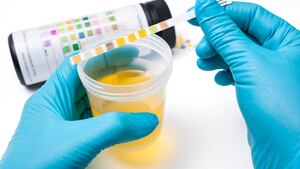If you are alive and in possession of a vagina, chances are you will have a urinary tract infection at some point in your life. UTIs are one of the most common bacterial infections, which might lead you to assume that modern medicine has nearly perfected its treatment options for this uncomfortable and potentially dangerous condition.
Unfortunately, you’d be wrong.
“If you have a run-of-the-mill urinary tract infection, you tend to get a lower-grade antibiotic,” Paul Garofolo, the co-founder and CEO of pharmaceutical company Locus Biosciences, told The Daily Beast. “And nowadays, 50 percent of the time you’re back in the doctor’s office within 30 to 90 days saying, ‘Hey, I got another one.’ And you’re pissed.”
The data show that as many as one in four of people who contract a UTI will have a recurrent infection, defined as more than one UTI in a six-month period, or more than three annually. Not only are these acutely painful, they can be frustrating and anxiety-inducing to deal with again and again. One study of 29 women with recurrent UTIs found that patients were worried about “creating a monster of a UTI infection that will be resistant to anything” and having other drug-resistant infections in the future. Others complained that using antibiotics for a UTI is “like killing a mosquito with a grenade,” but that doctors were unwilling to look to other treatments.
A number of factors we’re still investigating play a role in how susceptible someone is to recurrent UTIs, including the composition of the microorganisms in the urogenital tract, hormone levels, antibiotic resistance, and the body’s own immune system.
What is known, however, is that a course of antibiotics routinely prescribed for a UTI today is a ticking time bomb. “The fact that UTIs are very common, along with the fact that we don’t always do testing in a laboratory to determine which antibiotics are best suited, means it’s a good recipe for creating resistance,” Lisa Bebell, an infectious disease physician at Massachusetts General Hospital, told The Daily Beast. Broad-spectrum antibiotics that are used as second- and third-line defenses can have ripple effects on the body’s microbiome, and even lead to increased susceptibility for UTIs in the future by setting the stage for a vaginal yeast infection.
Unsurprisingly, scientists and patients want a better alternative. More modern UTI research today, of the kind Locus Biosciences is pursuing, take unusual and experimental approaches to see what treatments might clear the infection without wreaking more havoc on the body (and we’re talking about therapies that definitively cure or prevent infection—not cranberry juice).

Lisa Bebell
James Cook / Massachusetts General HospiralCrucially, this new research builds off of a counterintuitive and audacious proposal: What if we treated a bacterial infection with something other than antibiotics?
“The goal is most definitely to eventually knock antibiotics out of the treatment paradigm for these infections,” Garofolo said.
A Post-Antibiotic World
A fundamental question that could lead to better treatments is why certain people are more likely to contract a UTI that just won’t go away. Age matters a fair amount, as UTI rates are higher in young, sexually active women and postmenopausal women than in other groups. A confluence of research is starting to demonstrate that hormones and microbial communities may play a larger role than previously thought. One paper, published by researchers from Texas on Friday in the journal Cell Reports Medicine, clears up some of the murkiness surrounding these relationships, starting with the misconception that the breeding grounds for UTI-causing bacteria—the urinary tract and bladder—are sterile.
“Decades of medical dogma have assumed sterility of urine and the urinary tract; however, a robust body of work has established the existence of a human urogenital microbiome,” the authors wrote in the study. The microbiome consists of all the living microorganisms that reside in the human body, and disruptions in their balance may predispose people to certain diseases.
The Texas researchers studied the microbiomes and urine of 75 postmenopausal women with varying histories of UTIs, to figure out whether recurrent UTIs correlated with irregular microbiomes, and to identify causes for the imbalance. They found that the urogenital microbiomes of women with a history of recurrent UTIs had higher levels of bacterial groups that are commonly found during an active infection, versus women without a history of UTIs. On the other hand, women without a recurrent UTI history had higher levels of estrogen that were associated with more Lactobacillus species—probiotic strains of bacteria that may protect against infection.
Topical or vaginal estrogen cream for people who have gone through menopause may be helpful to break the cycle of recurrent UTIs, said Bebell, who was not involved with the research. She added that “the jury’s still out” and definitive evidence of estrogen’s benefit is needed.
At least one other trial is looking at whether another hormone—testosterone—can help prevent UTIs. In a small pilot trial published in May, researchers in New York found that a vaginal testosterone cream increased the abundance of Lactobacillus species and improved overall vaginal health. Larger sample sizes and longer follow-up will be needed to tell if the hormone can prevent UTIs, the authors wrote.
Others are pursuing a more permanent solution to UTIs: a vaccine that can be offered on a yearly or semiannual basis. Although some vaccines are already available to prevent UTIs in countries outside the U.S., Soman Abraham, a pathology researcher at Duke University School of Medicine, told The Daily Beast that these existing methods have not shown high levels of efficacy. “We believe that one reason why those current immune vaccines are not that protective is the antibody levels [they produce] aren’t high enough,” he said.
Abraham and his team think they may have found a better version, however—one that has been shown to reduce harmful bacteria in the bladders of mice threefold. The body responds to bacteria in the urinary tract by shedding cells in the walls of the bladder and calling off other immune cells until this process is complete; the vaccine, in contrast, overrides those signals and gives the fighters the go-ahead to take care of the bacteria before they can multiply. Abraham and his team are working to demonstrate their vaccine’s safety in other animals so that they can eventually test it in humans.
Race for the Cure
While estrogen, probiotics, and vaccines could be effective measures at preventing UTIs, there remains the issue of treating a UTI once contracted. For that, researchers have at least one surprising solution in the pipeline: phage therapy.
There’s another reason why using antibiotics to treat UTIs is like putting a square peg in a round hole, said Greg German, a medical microbiologist at the University of Toronto. Bacteria in the urogenital tract form biofilms, which are like a “wall of defense” that antibiotics can only partially permeate. Bacteria behind the biofilm remain unharmed, and can then reinfect an individual once they’ve finished a course of drugs.
“After medical school, I had a chance to treat patients with drug resistant infections and was very frustrated for all the patients having to use IV therapy extensively,” German told The Daily Beast. “I wanted to see if there was anything else that could be done; phage therapy was a natural opportunity.”
Bacteriophages are naturally occurring viruses that have evolved to be highly infectious to very specific strains or species of bacteria. As opposed to a broad-spectrum antibiotic that kills good and bad microorganisms with little discrimination, a cocktail of phages can instead wipe out the most common cause of UTIs, Escherichia coli, and have no other impact on the rest of the microbiome. German is recruiting for a single-person clinical trial that will test out a phage cocktail’s effectiveness at treating a drug-resistant UTI when the viruses are applied topically with a sponge.
One clinical trial that Garofolo’s company is recruiting for combines phage therapy with a first-line antibiotic; once they can demonstrate effectiveness with this combination, studies down the line can test the phages on their own for patients as a potentially life-saving treatment. “I always tell people, Hugh Hefner died from this,” he added. “A urinary tract infection can be fairly scary” for the millions of older adults who seek care for them each year.
These trials are critically important, and so is integrating alternative therapies into clinical practice as they are shown to be safe and effective, German said. One could envision a future where patients use these interventions in tandem—preventing infections with vaccines, creams, and probiotics, and treating ones that slip through the cracks with phages and first-line antibiotics.
“We need to come up with new techniques and strategies to target the germs in the bladder and in the kidney,” said German. “We're running out of antibiotics, and the bacteria are evolving or outsmarting those antibiotics faster than we can provide them.”









